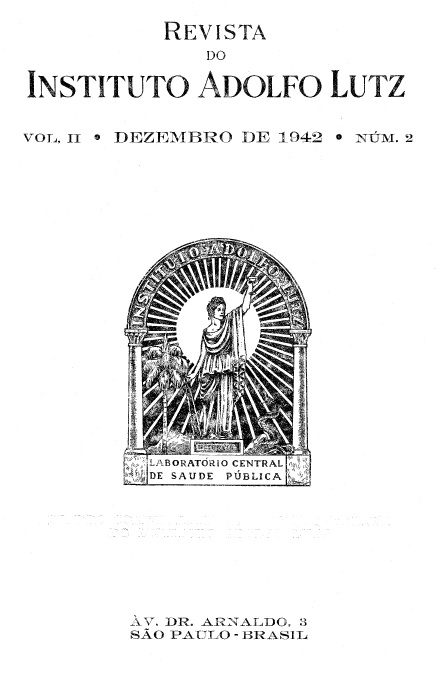Negative manita-indole members of Shigella genus
Abstract
S. dysenteriae, on the contrary of what is established in Bergey's manual, does not ferment raffinose and adonitol. A comparative study was made of S. dysenteriae strains and other mannitol-indole-negative organisms here isolated from clinical cases of dysentery, and having morphological, staining, cultural and biochemical characteristics very similar to those of S. dysenteriae. Serological tests evidenced that these organisms are homogeneous, but failed to show any relationship between the S. dysenteriae strains and the others, which, on the other hand, were found to be exactly identical with one representative strain of type Q771 from the Connecticut State Dept. of Health. Thus the occurrence of Shigella sp. Sachs Q771 in S. Paulo is here reported. The practical value of this observation is obvious when considered that if this type is regarded, as it was often until recently in several countries including Brazil, as "inagglutinable Shiga" because in routine biochemical tests used in the identification of Shigella species it is identical with S. dysenteriae, the use of Shiga antiserum, which would be recommended in this case as the specific treatment, would prove of no result. "Shigella Andrada", isolated by Sosa, in Buenos-Ayres, and Sachs type Q771 were found to be identical. As is concluded from a report presented by Hormaeche and Surraco in which these authors show an identity between one strain they have isolated and the "Shigella Andrada", type Q771 must occur also in Uruguay. Sorbitol and l-arabinose differentiate S. dysenteriae from the type Q771 of Sachs; this differentiation is not possible by morphological, staining and cultural characteristics, as well as by routine biochemical tests. S. dysenteriae fails to ferment any of them, while cultures of type Q771 produce, generally slowly, an acid reaction. However, the only representative strain of Shigella sp. Sachs Q1167 examined by the authors, which was also received from the Connecticut State Dept. of Health, presents the same biochemical behaviour as Shigella sp. Sachs Q771, although serologically distinct, proving thus the necessity of typing by means of specific sera. The authors have not worked with types Ql030 and Q454; but, Wheeler and Stuart, whose investigations about the subject are very complete and include all the Sachs types state that also these two types require to be differentiated specific type determination. The observations made repeatedly by the authors during many years about S. dysenteriae and strains type Q771 compared with those of Wheeler and Stuart presented in table I of this paper permit unless the contrary can be shown by future investigations, to differentiate by means of l-arabinose S. dysenteriae from the Sachs indole-negative types, since these produce acid from the carbohydrate above whereas with S. dysenteriae the contrary occurs. The distinction among these types is based on serological tests. The Sachs types will introduce modifications in the present taxonomic systems, Borman, Stuart and Wheeler (1944), in a detailed study on the taxonomy of the family Enterobacteriaceae, to which the Shigella genus belongs, state that probably soon the necessity for designating varieties will arise in the non-mannitol fermenting group, but that it is still early to determine the place of the recently described organisms such as Sachs types. Notwithstanding, through the report presented by Wheeler and Stuart, previously mentioned in this paper, some types of Sachs are excluded from the Shigella genus, while the inclusion of the others is confirmed, determining thus their taxonomic position. Strains of S. dysenteriae, Shigella sp. Sachs Q771 and the only one of Shiqella sp. Sachs Q1l67 examined do not ferment d-arabinose; probably the same occurs with types Q1030 and Q454. It is absolutely necessary that in publications about arabinose fermentation the optical variety be always mentioned. Based on their experimental findings, the authors insist on the necessity of employing always cultures and antisera S in agglutination tests. Beside many of the so-called "inagglutinable Shiga" reported, which are, in fact, not S. dysenterine but Sachs indole negative types, a great number exists which is a result of the use by the investigators of R forms instead of S. Finally the authors conclude that the S and R forms of S. dysenteriae are toxic; however no conclusion is made about which is the more toxic. Regarding the strains of Shigella sp. Sachs Q771 tested in identical conditions, neither the S nor the R forms reveal any toxicity.
Published
1947-01-23
How to Cite
Pestana, B. R., & Telles, L. de Q. (1947). Negative manita-indole members of Shigella genus. Revista Do Instituto Adolfo Lutz, 7(1-2), 8-40. Retrieved from https://periodicoshomolog.saude.sp.gov.br/index.php/RIAL/article/view/33169
Issue
Section
ORIGINAL ARTICLE










